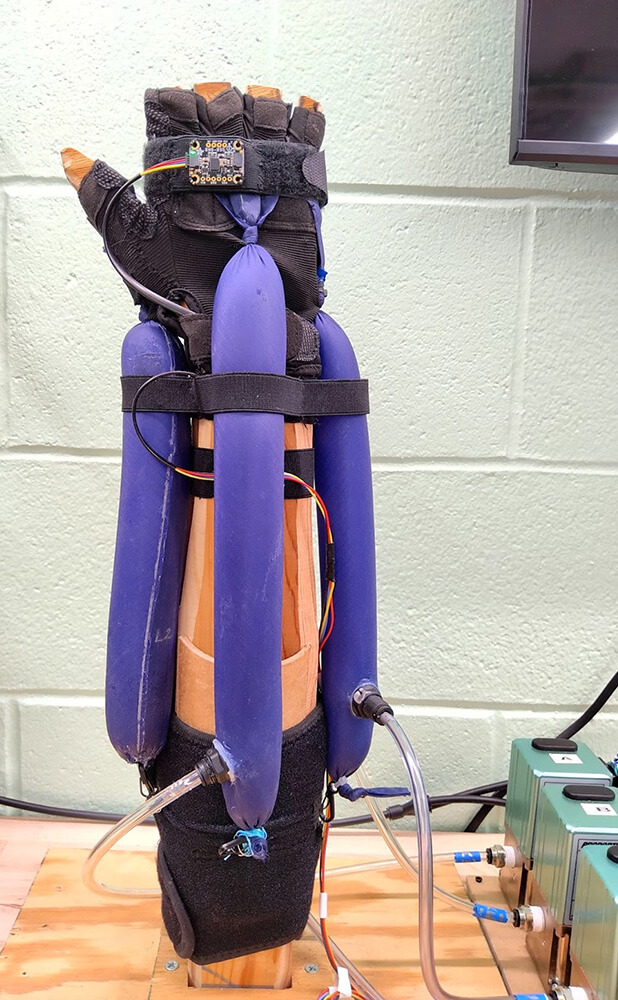Key Takeaway
 Proportion-Air QB3 high flow proportional electronic pressure controllers play a vital role in regulating the Fabric Pneumatic Artificial Muscles (fPAMs) of the Soft Wrist Exosuit developed by the IRIS lab at Notre Dame University. The QB3s ensure that the soft exosuit operates smoothly, efficiently, and safely during use.
Proportion-Air QB3 high flow proportional electronic pressure controllers play a vital role in regulating the Fabric Pneumatic Artificial Muscles (fPAMs) of the Soft Wrist Exosuit developed by the IRIS lab at Notre Dame University. The QB3s ensure that the soft exosuit operates smoothly, efficiently, and safely during use.
IRIS Lab Background
The Innovative Robotics and Interactive Systems (IRIS) lab specializes in advancing robotic technologies that improve human health, safety, and productivity. This lab is part of the University of Notre Dame’s Department of Aerospace and Mechanical Engineering.
Professor Margaret Coad leads the work in the lab, which focuses on designing, modeling, and controlling innovative robotic systems, including soft robotics. Soft robots are primarily made from flexible, compliant materials, such as silicone, rubber, or soft polymers, rather than rigid metal or plastic. Soft robots bend, stretch, and conform to various shapes, allowing them to perform tasks for which traditional rigid robots are not as well adapted.
One of the key research areas at IRIS, in which Proportion-Air has played a role, is the development of bio-inspired robots, which mimic movement found in nature, enabling them to perform tasks with smooth, fluid motions.
The Soft Wrist Exosuit Project
One project developed by IRIS Lab is the Soft Wrist Exosuit actuated by Fabric Pneumatic Artificial Muscles (fPAMs). This exosuit is designed to assist with wrist movements like flexion, extension, and ulnar/radial deviation. A primary advantage of the soft exosuit is that it provides assistance while maintaining comfort and safety for the user, which is particularly beneficial for tasks involving rehabilitation or human-robot physical interaction.
The lightweight exosuit uses four fPAMs arranged around the wrist, which inflate to create movement. The system incorporates sensors to measure wrist orientation and closed-loop pressure regulators to control the amount of air supplied to the muscles, ensuring precise and safe movements.
Margaret Coad, Assistant Professor in the Aerospace and Mechanical Engineering sector for the University of Notre Dame, was familiar with Proportion-Air products and wanted to use them for the Exosuit project. Prior to her work at Notre Dame, Margaret worked at both MIT and Stanford, where she had used Proportion-Air QB3 units. Proportion-Air QB3 units have proven to be ideal for soft robotics applications like the Exosuit.
The Role of the QB3 Controllers
Proportion-Air’s High Flow Electronic Pressure Controller is a complete electronic pressure regulating package consisting of two solenoid valves, a control circuit, a pressure transducer, an integrated volume booster and a rugged housing.
- Full vacuum to 150 PSI (10.34 Bar)
- Flows up to 30 SCFM
- Compact, space-saving single unit
The pressure transducer is connected directly to the control pressure so the closed-loop electronics and analog monitor signal can show what is happening in the process. The pressure sensor signal is continuously compared against the command signal to achieve the required set pressure.
In the Exosuit, the pneumatic systems rely on controlled air pressure to expand the muscle. The QB3 is integral to managing the precise control of air pressure delivered to the fPAMs. For this application, pressures are low, often 10 to 20 PSI.
The Results
For the IRIS lab’s Soft Wrist Exosuit, the Proportion-Air QB3 controllers delivered the following important advantages:
- Precise Pressure Regulation – Ensures the correct amount of air pressure is supplied to the fPAMs to control contraction and relaxation. Muscles are sensitive to changes in pressure, so fine control is needed for smooth and accurate movements.
- Closed-Loop Control – A high-flow controller provides real-time feedback between the pressure and the movement sensors. As the wrist moves, sensors detect the motion and send signals to the controller, adjusting the air pressure as needed. This feedback loop ensures that movements are responsive and matched to the user input.
- Management of Variable Flow Demand – Since the fPAMs require variable amounts of air depending on the movement, the high-flow controller delivers large volumes of air quickly when needed for rapid or larger movements, but also fine-tunes smaller adjustments for precise movement.
- Safe and Adaptive Response – The controller also manages pressure limits to avoid over-inflation or under-inflation of the pneumatic muscles, ensuring the user’s safety and maintaining the exosuit’s durability.
Contact us to learn more about Proportion-Air’s accurate, repeatable, customizable proportional pressure and flow control solutions.
